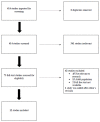Comparison of the Clinical and Laboratory Features of COVID and Influenza in Children
- PMID: 36119462
- PMCID: PMC9448268
- DOI: 10.4084/MJHID.2022.065
Comparison of the Clinical and Laboratory Features of COVID and Influenza in Children
Abstract
Background and objectives: Coronavirus disease 2019 (COVID-19) is caused by SARS-CoV-2 and has a clinical presentation ranging from an asymptomatic course to flu-like syndrome up to respiratory failure. Seasonal Influenza, due to the influenza viruses and very common in children, can cause symptoms similar to COVID-19. In order to identify clinical and laboratory characteristics that allow healthcare workers to differentiate COVID-19 from Influenza, we performed a systematic review of the existing literature on the pediatric age. Methods. The research was done via PubMed for articles published from March 2020 to October 2021, combining the MeSH words "COVID-19" and "Influenza" and "Children" and considering the suggestions of the PRISMA Group.
Results: The most frequently described symptoms were fever and cough in both groups. In most studies, high fever, cough, nasal congestion or rhinorrhea, vomiting, and muscle pain were detected more frequently in the Influenza group. Regarding the value of laboratory tests, the results were mixed. Almost all studies reported significantly lower levels of C-reactive protein and procalcitonin in the COVID-19 group than in the Influenza group. In most manuscripts, COVID-19 had a milder course than Influenza.
Conclusions: No symptoms are characteristic of a single infectious agent, with flu-like disorders being the most common. In addition, laboratory tests do not help in the differential diagnosis; however, they show a limited inflammatory response in COVID-19, which could explain the fewer complications compared to adulthood, with a less severe clinical course.
Keywords: COVID-19; Children; Influenza.
Conflict of interest statement
Competing interests: The authors declare no conflict of Interest.
Figures
Similar articles
-
Comparison of Clinical Features of COVID-19 vs Seasonal Influenza A and B in US Children.JAMA Netw Open. 2020 Sep 1;3(9):e2020495. doi: 10.1001/jamanetworkopen.2020.20495. JAMA Netw Open. 2020. PMID: 32897374 Free PMC article.
-
Comparison of hospitalized patients with pneumonia caused by COVID-19 and influenza A in children under 5 years.Int J Infect Dis. 2020 Sep;98:80-83. doi: 10.1016/j.ijid.2020.06.026. Epub 2020 Jun 12. Int J Infect Dis. 2020. PMID: 32535301 Free PMC article.
-
Real Asymptomatic SARS-CoV-2 Infection Might Be Rare: Importance of Careful Interviews and Follow-up.J Korean Med Sci. 2020 Sep 21;35(37):e333. doi: 10.3346/jkms.2020.35.e333. J Korean Med Sci. 2020. PMID: 32959547 Free PMC article.
-
Comparison of the clinical differences between COVID-19, SARS, influenza, and the common cold: A systematic literature review.Adv Clin Exp Med. 2021 Jan;30(1):109-114. doi: 10.17219/acem/129573. Adv Clin Exp Med. 2021. PMID: 33529514
-
Clinical Presentation of COVID-19: A Systematic Review Focusing on Upper Airway Symptoms.Ear Nose Throat J. 2020 Nov;99(9):569-576. doi: 10.1177/0145561320920762. Epub 2020 Apr 13. Ear Nose Throat J. 2020. PMID: 32283980
Cited by
-
Clinical and Paraclinical Peculiarities of SARS-CoV-2 and Influenza Infections in Children: A Comparative Study.Life (Basel). 2025 May 14;15(5):784. doi: 10.3390/life15050784. Life (Basel). 2025. PMID: 40430211 Free PMC article.
-
Procalcitonin and Presepsin as Markers of Infectious Respiratory Diseases in Children: A Scoping Review of the Literature.Children (Basel). 2024 Mar 15;11(3):350. doi: 10.3390/children11030350. Children (Basel). 2024. PMID: 38539385 Free PMC article.
-
Epidemiology and Clinical Characteristics of Laboratory-Confirmed COVID-19 and Influenza Infections in Children: A 2015-2024 Study in Taiwan.Microorganisms. 2025 Feb 26;13(3):517. doi: 10.3390/microorganisms13030517. Microorganisms. 2025. PMID: 40142409 Free PMC article.
-
Clinical and Epidemiological Presentation of COVID-19 among Children in Conflict Setting.Children (Basel). 2022 Nov 8;9(11):1712. doi: 10.3390/children9111712. Children (Basel). 2022. PMID: 36360440 Free PMC article.
-
Diagnosis and Prognosis Evaluation of Severe Pneumonia by Lung Ultrasound Score Combined with Serum Inflammatory Markers.Mediterr J Hematol Infect Dis. 2023 Nov 1;15(1):e2023057. doi: 10.4084/MJHID.2023.057. eCollection 2023. Mediterr J Hematol Infect Dis. 2023. PMID: 38028392 Free PMC article.
References
-
- [accessed 06/01/2022]. Available at https://covid19.who.int/
Publication types
LinkOut - more resources
Full Text Sources
Research Materials
Miscellaneous


